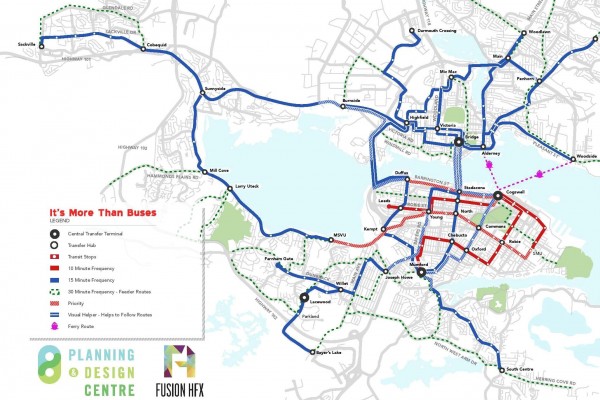In September, It’s More than Buses, a grassroots advocate for better transit, launched our idea for a frequent network to show how our principles could work in HRM’s transit system. Our proposal is shown above. It is the fullest vision of how we believe Halifax Transit should design core transit services. It uses 75% of existing resources; the other 25% can be used to provide more coverage across the region.
The essential elements behind our proposal are based on public engagement. These elements have evolved over three years, but our principles and approach remains the same. In short, we believe that more transit resources should be dedicated to fast, frequent and reliable service. Halifax Transit must provide high quality service to many more riders. Slow, winding bus routes leaving every half hour are currently the core service. Poor service won’t attract many new riders, and is no longer acceptable. We need more than a new network. We need a new approach.
In January, Halifax Transit will unveil a draft transit network, based on their Moving Forward Principles. We support these strong principles and want to see them put into effect. To implement their principles, Halifax Transit’s draft should have the following elements:
A clearly branded frequent network
Service every 15 minutes or better, all day and into the evening, on major corridors. This allow riders to travel with minimal waits, simple transfers and less reliance on schedules. This service is branded as the core part of the entire Halifax Transit system.
Simpler routes and better corridors
High frequency, high ridership services run on long, straight regional corridors where transit has priority. No streets have more than a handful of routes.
Transit Priority
Transit has the edge at chokepoints, intersections and along major corridors. Transit priority is used to help frequent routes, rush hour routes and express routes.
More service where people will use it
More frequent service and higher quality routes will be provided along major urban corridors. More service is put in places where many people live and work. This includes: the Halifax Peninsula; Dartmouth within Highway 111; Fairview; Sprfyield; and major suburban corridors in Bedford, Clayton Park, Dartmouth, Cole Harbour and Sackville. Services should be clearly defined as mainly to attract lots of riders (ridership routes) or mainly to provide basic transit coverage to as many people as possible (coverage routes). It’s More than Buses proposes that 75% of resources should be devoted to ridership routes.
Useful Transfers
A connected, regional network of frequent routes allows many riders to easily make crosstown trips to major destinations like MicMac Mall, Bayers Lake, NSCC campuses and Mount St. Vincent University. Transit is useful beyond commuter trips to Downtown Halifax.
Transfer Hubs
Main terminals, small hubs and important street corners all have shelters, platforms, wayfinding signs, real time arrival information and crosswalks designed to make transfers easy, safe and comfortable.
Fewer stops but better stops
Stops are more widely spaced to speed up travel, but more stops have shelters, benches, lighting, maps and schedules.
In short, we are advocating for Halifax Transit to focus on the quality of transit service, not just the quantity of transit service. In January, Halifax Transit will launch its draft network and begin public consultations. We don’t know what that network will look like, but we will continue to advocate for our ideas and for our essential elements of high quality transit. Please help!
- Call or email your councillor and tell them you want frequent, high quality transit service.
- Like It’s More than Buses on Facebook, or follow us on Twitter (@morethanbuses).
- Become a Transit Champion! Your organization and business can publicly endorse or principles. Email us at morethanbuseshalifax@gmail.com for more information.
- Volunteer with It’s More than Buses. Email us at morethanbuseshalifax@gmail.com to find out how you can help.
Sean Gillis is a professional urban planner and amateur transit nerd. He is a member of the grassroots advocacy group ‘It’s More than Buses.’


One comment
Would like to see an Accessibility component to your advocacy considering we have an aging population with a growing demand for improved accessible transit services.